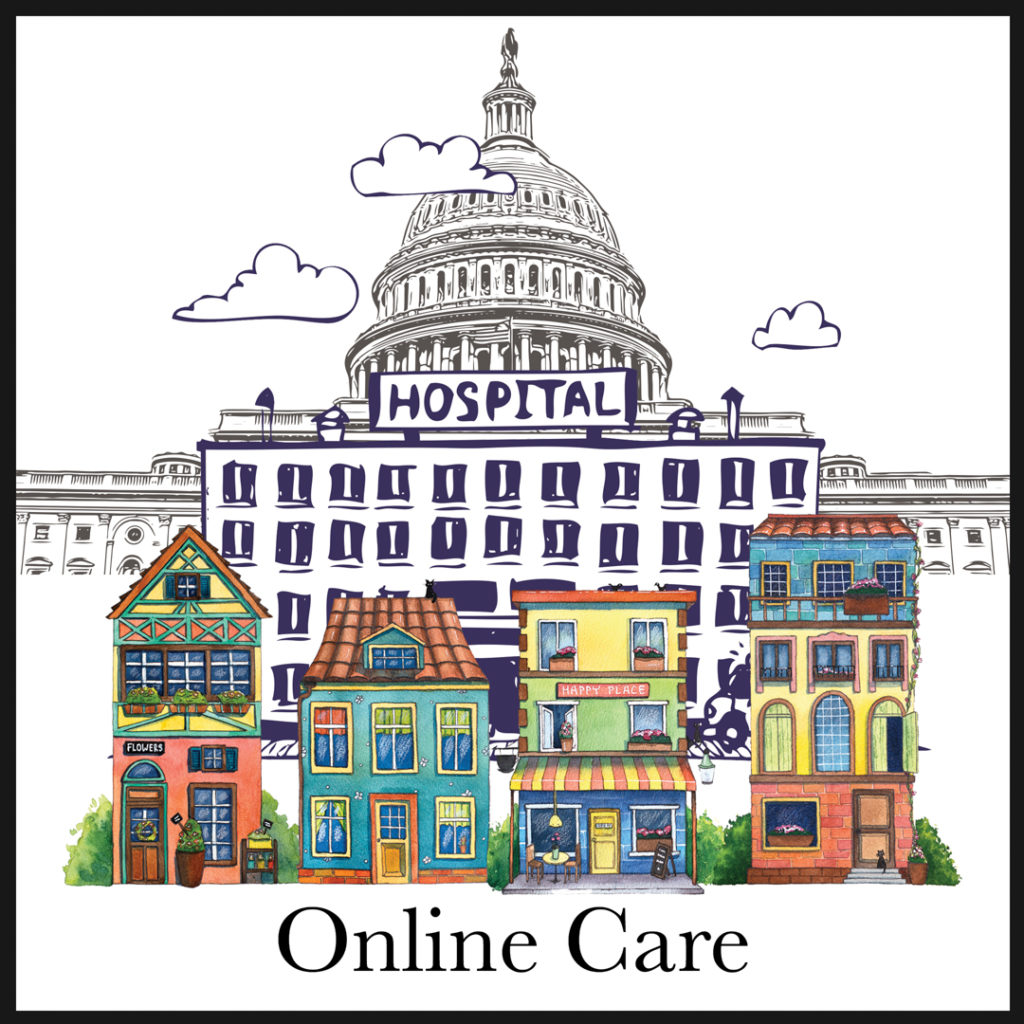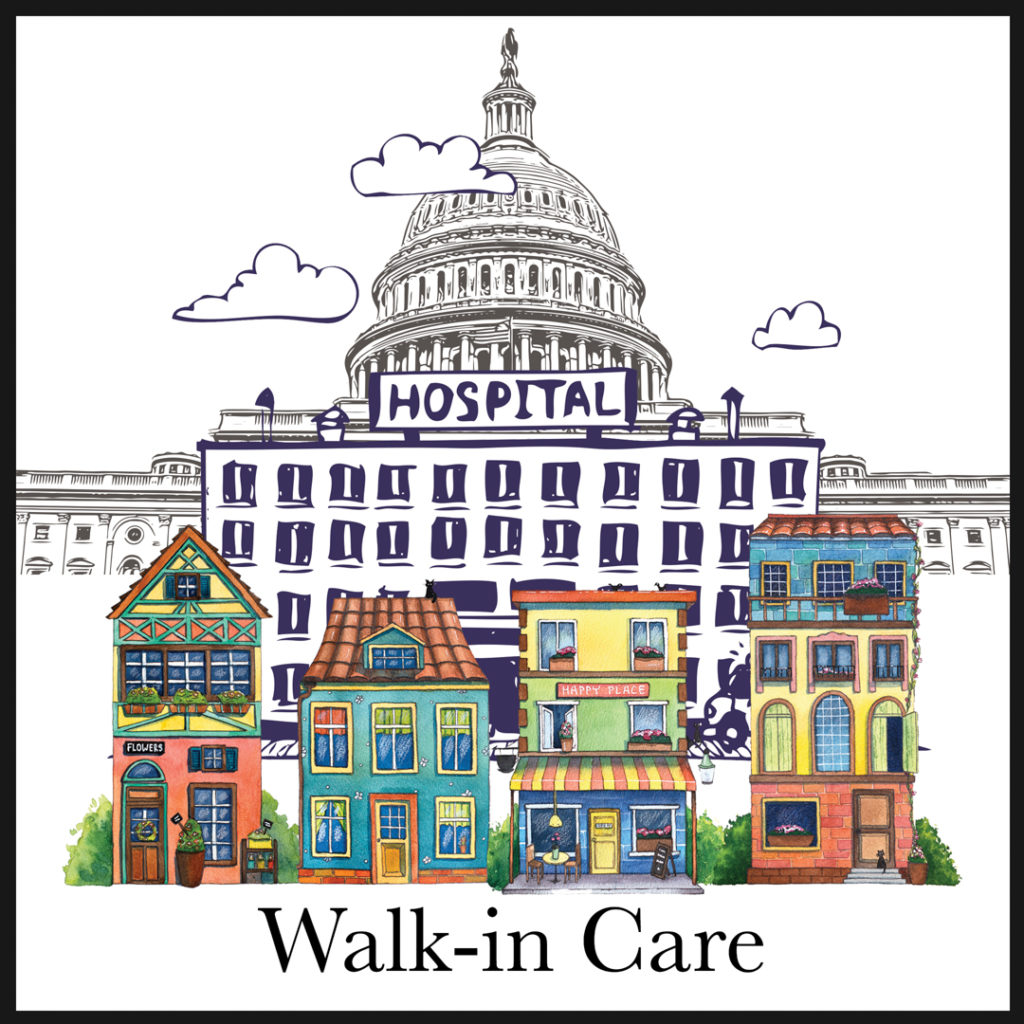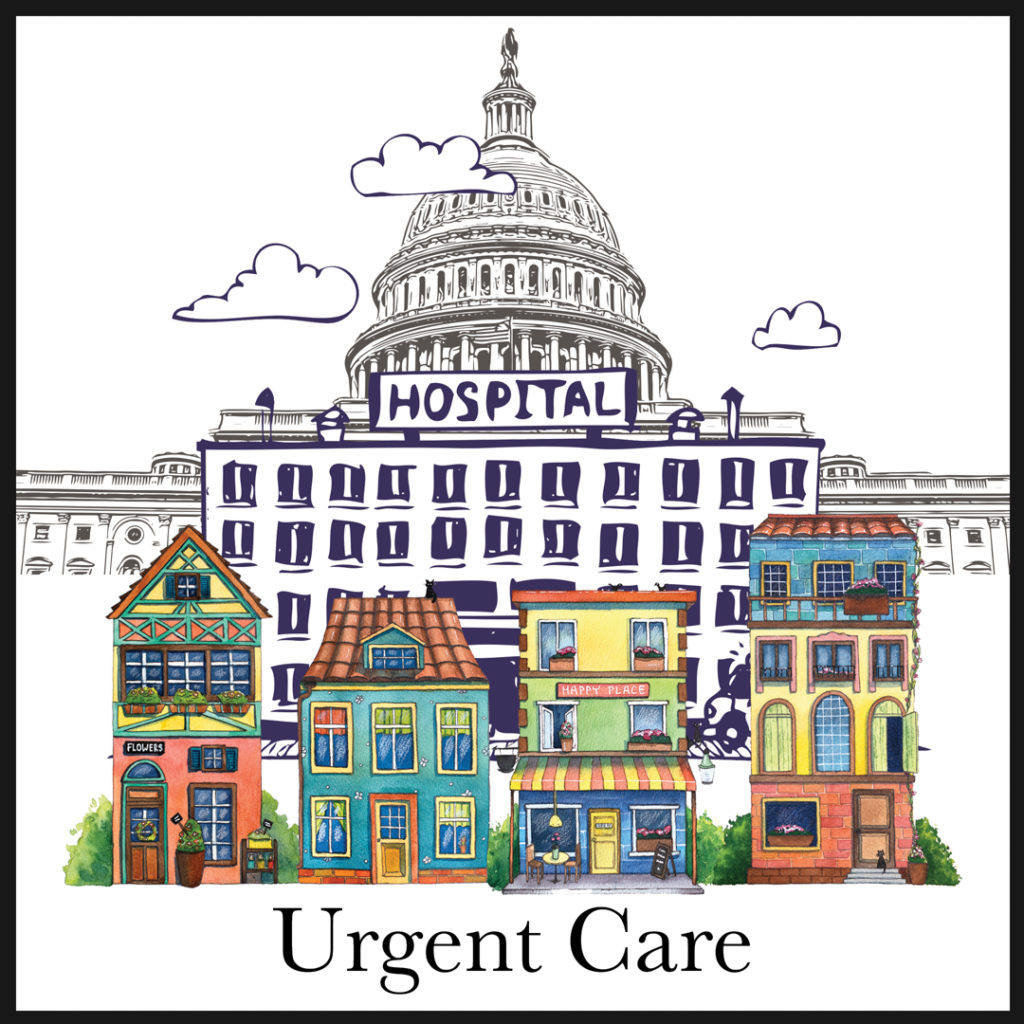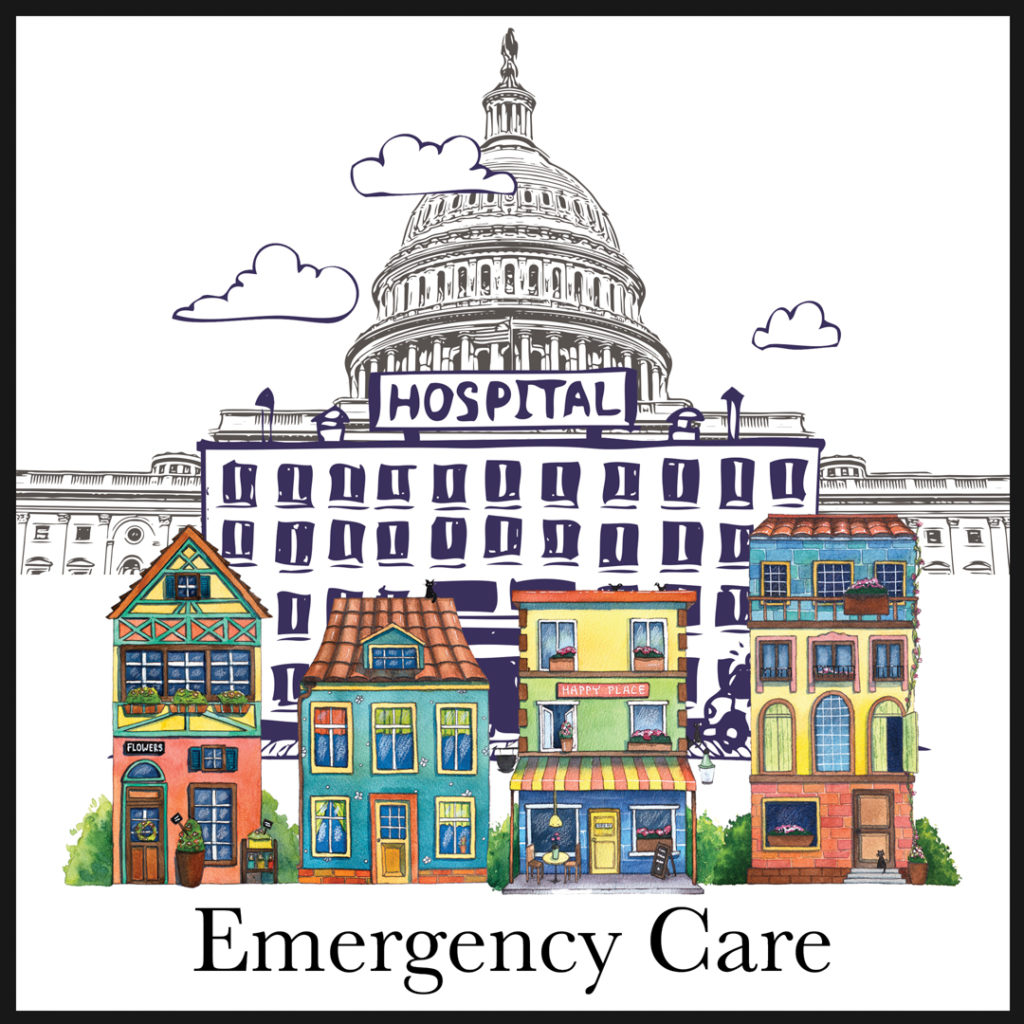The Third Option will designate 4 levels of care…
Level One
Minimal Care: everyday annoyances where an over-the-counter remedy will suffice.
Level Two
Manageable Care: May need a diagnosis, even a prescription, but not urgent
Level Three
Urgent Care: Need to be treated that day, but can get there under your own power
Level Four
Emergency Care: Life-threatening, we need to come and get you
There will be 4 ways to enter our system initially…
1. Home / Online
- Access your Account, where your [entire] medical records are available to you and all authorized personnel.
- Consult a symptom database
- Order lab tests (some which can be sent to you, some a nurse can administer in your home, some you will need to come in to do [you can schedule the appointment online]
- Ask questions online, and if a doctor /counselor visit is warranted, navigate to all schedules and book appointments yourself. In some cases, tests or visits can be performed online, with any resulting prescription either sent to your home, or made available for pick-up.
- Book Preventative Services / Screenings, or outpatient / inpatient consultations.
- Make Copays for appointments or prescriptions within your Account.

Online Care Logistics
$50 Billion is set aside to build this online System, with tools for booking appointments, accessing data about yourself or your symptoms, initiating telemedicine options, ordering or performing basic testing or lab work, etc. – most importantly, the data is accumulated nationwide, which will help with general census-taking, accounting (cost assessment), and health management (best practices). NOTE: Remember, this system is for all of us, so when the smart people all pitch in their time to build it, We will hopefully get the “Friends and Family Discount”.
2. Walk-in Clinic [Within Community Center “Hubs”]
Retail Hub
- Drug store, among many other small businesses, that will help pay for the operation of the Community Center
Walk-in Clinic
- Pharmacy / clinic where pharmacists can write certain prescriptions (birth control, asthma inhalers, thyroid pills), or refer people to an onsite nurse practitioner, physician assistant, or doctor [many tests can be done on site, immunizations, vaccinations, referrals, etc ]
- Counseling Services – initial consultations / assessments can be done here: Smoking, alcohol & drug abuse, obesity, depression, mental health issues, even help in initiating healthy lifestyle options (nutrition, exercise, etc) Yearly mental health screenings, peer support groups, therapy, etc. [Appointments can also be made online]
- Child Preventive Services
- Screenings: PKU, STI’s, Vision, Obesity, Hypothyroidism, HIV, Sickle Cell, Hemoglobin, Dyslipidemia, Depression, Developmental, Cervical dysplasia, Autism, Hearing
- Assessments: Oral Health, Behavioral, Alcohol / Drug, Blood Pressure, etc.
- Testing: TB, Lead
- Supplements: Fluoride chemoprevention, Iron
- Family Services
- Counseling: Social Workers, family resources, in-home therapy, parenting classes, Big Brothers / Sisters, Peer Programs, Family Housing – NOTE: potentially 122 children in 100,000 population are foster kids, and numbers indicate that 73 or more return to their home eventually. 1st goal: keep the family together. Support and counsel parents and children, bring in mentors, nannies, volunteer peers, and even offer “Family Housing” where families stay together in a neutral place and work on their issues using intermediary help.

Walk-in Care Logistics
The Community Center Structure itself will be covered through the Bank ($20 yearly Community Center fee, paid by all 100,000 citizens, will cover the cost of this infrastructure). Also, much of the retail services, besides paying for themselves, will procure profits that go directly toward financing the health services within this building.
NOTE: A typical city block is 660 X 330 feet, or 217,800 square feet. The Community Center will need to be this large.
$6.87 Billion will also be set aside for Temporary or Transitional Housing above the Community Centers
Pharmacy
Most of costs will be for inventory (as much as $1.2 million a year). Even though the pharmacy will make money, and pay rent back to us, let’s pretend we must cover all costs, including staff salaries. $1.6 million per Center X 3271 Communities = $5.3 Billion
Walk-in Clinic
14,816 customers per 100,000 (41 per day) go to Emergency rooms, when they should be going to our new walk-in clinics instead. We will no longer refuse service at any facility, but will refuse to treat people if they show up to the wrong facility. All healthcare infrastructure will be close by, however, with transport available in emergency situations.
Another 80 customers per day go to Urgent Care when they could also go to our new walk-in clinic instead. As people have a choice, we will only add half of these to our total (40 per day)
81 potential customers per day Equals 3 “Teams”, each consisting of
- 1 Physician ($210k)
- 1 Physician Assistant ($120k) and / or
- 1 Nurse Practitioner ($115k)
- 1 receptionist ($35k)
- 1 Medical Assistant ($40k)
- 1 Medical Tech ($50k) and
- 1 Administrator ($75k)
These Teams will cover our hours from 7am to 7pm, 6 days a week, in whatever rotation they decide is best (if things are slow, individuals may be needed at Urgent Care or several other of our facilities) [Remember, our new maximum work week is 30 hours] $530k per Team X 3 Teams X 3271 Centers = $5.2 Billion
OPERATING COST:
For Health Care’s extra costs (Labs, IT, drug supply, imaging, medical / surgical supplies, even furniture and equipment), We will always use 40% of salary costs to give us a substantial amount to set aside. 40% of $5.2 Billion = $2.08 Billion
Counseling
Currently we have 14.8 million US citizens facing depression or 4525 per 100,000. 1434 per 100,000 have illegal substance abuse issues (opioids, heroin, cocaine, methamphetamines, hallucinogens, etc). 5200 per 100,000 have an Alcohol Use Disorder. 8600 youths per 100,000 have a Tobacco Use Disorder. 1250 per 100,000 have a Cannabis Use Disorder. If counselors see 30 cases per week for 20 sessions, each counselor could help as many as 72 patients in a year.
- 230 Drug and Alcohol Counselors for 16,500 afflicted
- [$60k salary X 230 = $13.8 million in salaries]
- 62 Clinical Psychologists / Counselors for 4500 afflicted
- [$75k salary X 62 = $4.65 million in salaries]
- 40 Psychiatrists to prescribe meds to 13-17,000 afflicted
- [$240k X 40 = $9.6 million in salaries]
Total Salaries = $28.1 million X 3271 locations = $91.75 billion
TAKEAWAY: This seems like too many people need help. On all issues we must attack the problem from both sides, so we will hire a boat load of counselors, etc., but instead of just throwing money at the problem (which is the easy way out sometimes), we need to also get at the root of why so many people need to be rescued. As we attempt to get to the bottom of that, our initial strategy could be this:
OFFICES (located at Behavioral clinic and Community Center)
- 24 offices for One “Team” – Helping 600 to 1500 people / yr
The Mental Health Team consists of:
- 2 Psychiatrists (prescribing meds to 600 + people a month) [$480k]
- 4 Psychologists / Psychiatric Nurses (seeing 120 people a month) [$300k]
- 8 Counselors (helping 240 people a month) [$480k]
- 8 Social Workers (serving 240 people a month) [$480k]
There are many types of Social Workers that could be on the Team:
- Clinical
- Gerontological
- Mental Health and Substance Abuse
- Community
- Medical and Health
- 2 receptionists [$70k]
- 2 Administrative “Team” Managers [$150k]
We will also build 100 offices at the Behavioral Clinic location, capable of housing 4 Teams, with another 24 offices at the Community Center for extra meeting space (and for the possible addition of another Team in the future, if necessary)
SALARIES:
$2 Million per Team X 4 Teams = $8 million X 3271 locations = $26.2 Billion in salaries
INFRASTRUCTURE COSTS:
100 offices with 4 reception areas, 4 waiting rooms, 8 bathrooms, 4 conference rooms, etc. = 22,000 square feet X $200 per sq. ft. = $4.4 million X 3271 locations = $14.4 Billion Loan
Within the Community Center, we will house our Family Help Center:
- Temporary Housing Units (20, used for many purposes)
- School Tutoring (Adults and High School students will be employed)
- Child / Family Social Workers [$60k]
- Family Counseling [$60k] Spaces for programs (like Daddy Boot Camps, Mom Clubs, Big Brother and Sister Services, other Peer Group Programs, etc.)
- Childcare Services
Our new paradigm dictates that our best chance to produce sustainable adults is to invest upfront in families. Midwives will be available prenatal to postpartum. Of the 9500 families with children in a 100,000 population, typically 10% have special needs. Social Workers will be available to see 20 different families a week for at least a month. If even more intensive help is required, Family Counselors will step in. For working parents, affordable childcare will be available. 3600 children per 100,000 are 3 yrs old or less [1:3 ratio for infants, 1:4 for 1 yr olds, 1:6 ratio for 2 yr olds] Once your child turns 3 years old, they will attend daycare at a designated school, where teachers will supervise, and education will begin]
- Midwives (1 for 30 babies / year) = 40 needed X $110k each = $4.4 million
- Social Workers (20 cases a month) = 5 workers X $60k each = $300k
- Social Workers for various pre and post parenting classes = 5 workers X $60k each = $300k
- Family Counseling (30 cases a week) = 5 workers X $75k = $375k
- Childcare / Babysitting Services (for 900)
- $35k for leaders X 30 = $1.05 million
- $24k for workers X 200 = $4.8 million
- Receptionists = 3 X $35k each = $105k
- Family Service Administration = 6 X $75k each = $450k
Rough Total of Staff Salaries = $12 million X 3271 locations = $39.3 Billion [We will recoup some costs (small childcare fee, copays for health services), but would rather calculate worst-case scenarios]
INFRASTRUCTURE COSTS: Temporary Housing
- 5 – 1 bedroom (600 sq. ft.) = 3,000 sq. ft.
- 5 – 2 bedrooms (900 sq. ft.) = 4,500 sq. ft.
- 5 – 3 bedrooms (1200 sq. ft.) = 6,000 sq. ft.
- 5 – 4 bedrooms (1500 sq. ft.) = 7,500 sq. ft.
TOTAL = 21,000 sq. ft. X $200 per sq. ft. = $4.2 million X 3271 locations = a $13.74 Billion Loan
3. Urgent Care
Wait times will be posted online for each Urgent Care facility. You can even sign into an online “queue”, though your name will be passed over if you are not present when called [You will be able to see the queue moving online] NOTE: Urgent Care Facilities will be open 24 hours to prevent overcrowding in Emergency Care after hours. All Urgent Care facilities will be in close proximity to Emergency and Inpatient Care in case a higher level of care is needed. Numbers indicate that We should prepare to see 135-150 patients a day per 100,000 population.

Urgent Care Logistics
Infrastructure Loan Cost: $6.54 Billion, which covers the building of an Urgent Care in every Community. A 5000 square foot building X $400 per sq. ft. = $2 million x 3271 facilities = $6.54 billion
Plan: A Physician Team consists of:
- 1 Physician ($210k salary)
- 1 Physician Assistant ($120k salary)
- 1 Nurse Practitioner ($115k salary)
- 3 Medical Assistants ($40k salary each)
- 3 Medical Technicians ($50k salary each)
- 2 Receptionists ($35k salary each)
- 1 Team Manager / Administrator ($75k salary)
We will need 9 exam rooms for these 3 “doctors” (each armed with an assistant and a tech) to see 12 patients in an hour. Because some patients need more time in a room depending on the seriousness of their situation, we will build 3 extra exam rooms, one for each doctor.
SALARIES:
Each “Team” costs $860k, but only works for 30 hours a week. We would need 6 teams to cover our 24/7 care mandate. Because everyone is on salary, they may expect to go over their 30-hour week if necessary. Figuring in a 7th Team could allow for a week off in each Team’s rotation, to hopefully help avoid burnout. $860k X 7 = $6.02 million X 3271 facilities = $19.7 Billion
OPERATING COSTS:
For Health Care’s extra costs (Labs, IT, drug supply, imaging, medical / surgical supplies, even furniture and equipment), We will always use 40% of salary costs to give us a substantial amount to set aside. 40% of $19.7 Billion = $7.88 Billion
4. Emergency Care

GOALS:
- Change our transportation infrastructure to provide more direct access to this facility.
- Upon arrival, patients should be immediately redirected to Urgent Care, Behavioral Care, or even the Walk-in Clinic, in order to take only the patients suitable for this level of care. Even among those remaining on site, further separation of patients into either intensive care (critical condition) or more progressive care (when patient is stable) will occur.
Emergency Care has advanced diagnostic and laboratory facilities and is capable of treating any emergency medical condition – therefore, it is always staffed by emergency physicians (any non- emergency cases will need to be redirected to the appropriate facility). Although emergency facilities often see 115 patients per 100,000 population in a given day, in reality only 10-11 per day are actual emergencies (and only 1-2 of those are deemed “critical”).
The future: Hybrid operating rooms, and a complete upgrade of our 9-1-1 system and our Emergency Medical Service (EMS)
Emergency Care Logistics
Infrastructure Loan Cost: $75.2 Billion covers the building of Emergency Care in every Community. Typically, We will build 12 beds, 2 OR’s ($1.5 million per bed X 12 + $6 million for 2 OR’s) = $23 million X 3271 Communities.
A Hybrid Operating Room is a surgical theatre that is equipped with advanced medical imaging devices such as fixed C-Arms, CT scanners or MRI scanners. These imaging devices enable minimally-invasive surgery – The floor-mounted system uses the least amount of space; a ceiling-mounted angiography system needs more space while a floor-mounted angiography robot requires the most space. Minimum space required is 60 sq. Meters (26 X 26 feet). Each on costs $3 million to build, and can be used for cardiovascular, orthopedics, neurosurgery, traumatology, etc.
INFRASTRUCTURE – 12 beds, 2 OR’s ($1.5 million per bed X 12 + $6 million for 2 OR’s) = $23 million X 3271 = a $75.2 Billion Loan
COSTS:
In two different analyses, costs worked out to about $2200 per bed per day or $803,000 / year. 12 beds would average $9.64 Million. In this scenario, supplies would be 15% of this or $1.45 Million, and staff would be 58% of this or $5.6 Million. $9.64 million X 3271 locations = $31.53 Billion
NOTE: Using data from The University of California Davis Medical Center (UCDMC), that is 60 times the size of our proposed hospital in both beds and population served (they service 6 million people with 625 beds), they claim a $1.7 Billion a year budget, meaning our annual budget might be as large as $28.33 million a year X 3271 facilities = $92.7 Billion [quite a bit larger than my number…hmmm]
Complete upgrade of our 9-1-1 system and our Emergency Medical Service (EMS)
TAKEAWAYS:
- Stand-alone emergency care is not super cost-effective.
- Ambulances are not very cost effective either, and are also loud and hard to work in, and occasionally crash into things.
- The Fire Department is not cost effective either. 80% of 9-1-1 calls to Fire Departments are medical rather than fire related. [Dispatchers utilize them for medical calls as ambulances are often stretched too thin]
- “9-1-1” has issues. It needs 21st century telecommunication infrastructure updates (multimedia communications in a wireless, mobile society) It has too many false alarms and non-emergency calls (does implementing 3-1-1?) Nationwide, there are 6,000 public safety answering points (PSAPs), or 9-1-1 call centers, purportedly under state and local jurisdiction, meaning the Feds (specifically the FCC) can’t really tell them what to do.
- EMT’s and even paramedics are mostly there to stabilize patients and get all possible information, then relay that to a doctor without trying to play doctor. Are EMT’s well enough trained? If John Lennon is bleeding out on the sidewalk, what system would be needed in order to save him?
THOUGHTS:
- we will be forced to place the emergency care, the behavioral care, the inpatient hospital care, and even the urgent care within a stone’s throw of each other, so we can simultaneously take care of everyone while hopefully getting people to the right care (and don’t forget sustainable architecture that blends in with the community!)
- Is a third party dispatch the most efficient method? Before we spend money to update the 9-1-1 system, have all options been explored? The next big thing seems to be Next Gen 9-1-1, an entirely VoIP-based connection, where calls are sent to emergency dispatch entirely over IP, bypassing the old system. The all-VoIP connections enable photos, video, and text messaging, and locations are determined and transmitted at the time of each call. What else? Should people at risk be given a wearable monitor / alert / GPS device? Cars have ACN systems (automatic crash notification) that has gotten quite sophisticated.
- Maybe a “Next Gen 9-1-1″ is not the problem, but our emergency transportation system and response strategy seems sketchy.
- Can we have a response team that can do procedures on the spot? With our Emergency Care in every community, and medical personnel at the ready, couldn’t our response vehicle be loaded with mobile equipment and people proportional to the task?
- And couldn’t that “portable med unit” at least be able to go right through a door, into a home, to help people right where they lay?
- And couldn’t that response vehicle have its own clear path, even if that path may have to be above the normal flow of traffic? (See New Transportation)
- And can our paramedics and firemen go out in the community and provide important services like urgent care, medication treatments, etc. during down times, not to overwork them, but to utilize their full potential while on the job? [see Massachusetts para medicine mobile integrated health pilot programs]
NOTE: In this scenario, EMT’s will need more education, and paramedics and nurses will need to be interchangeable

